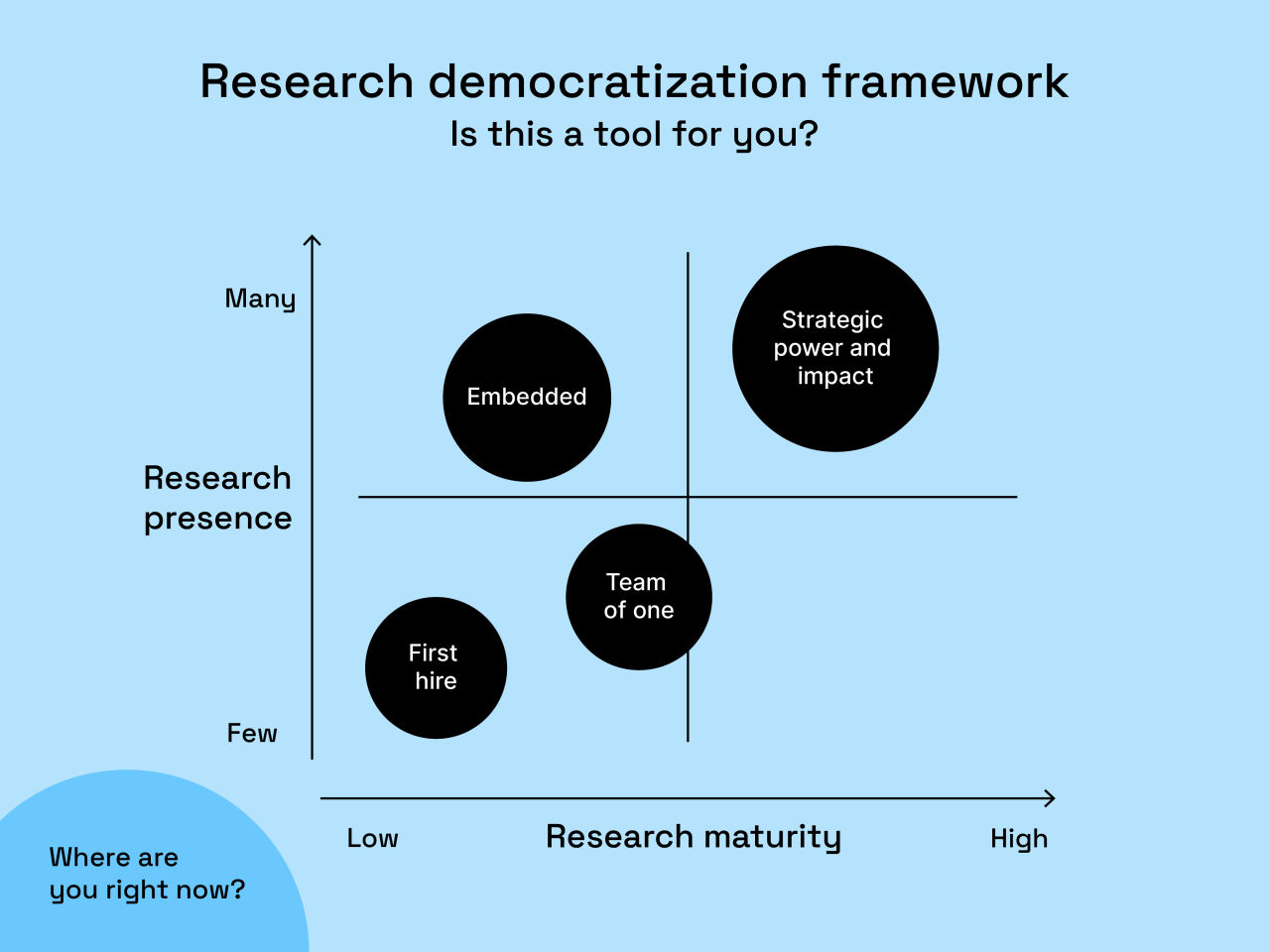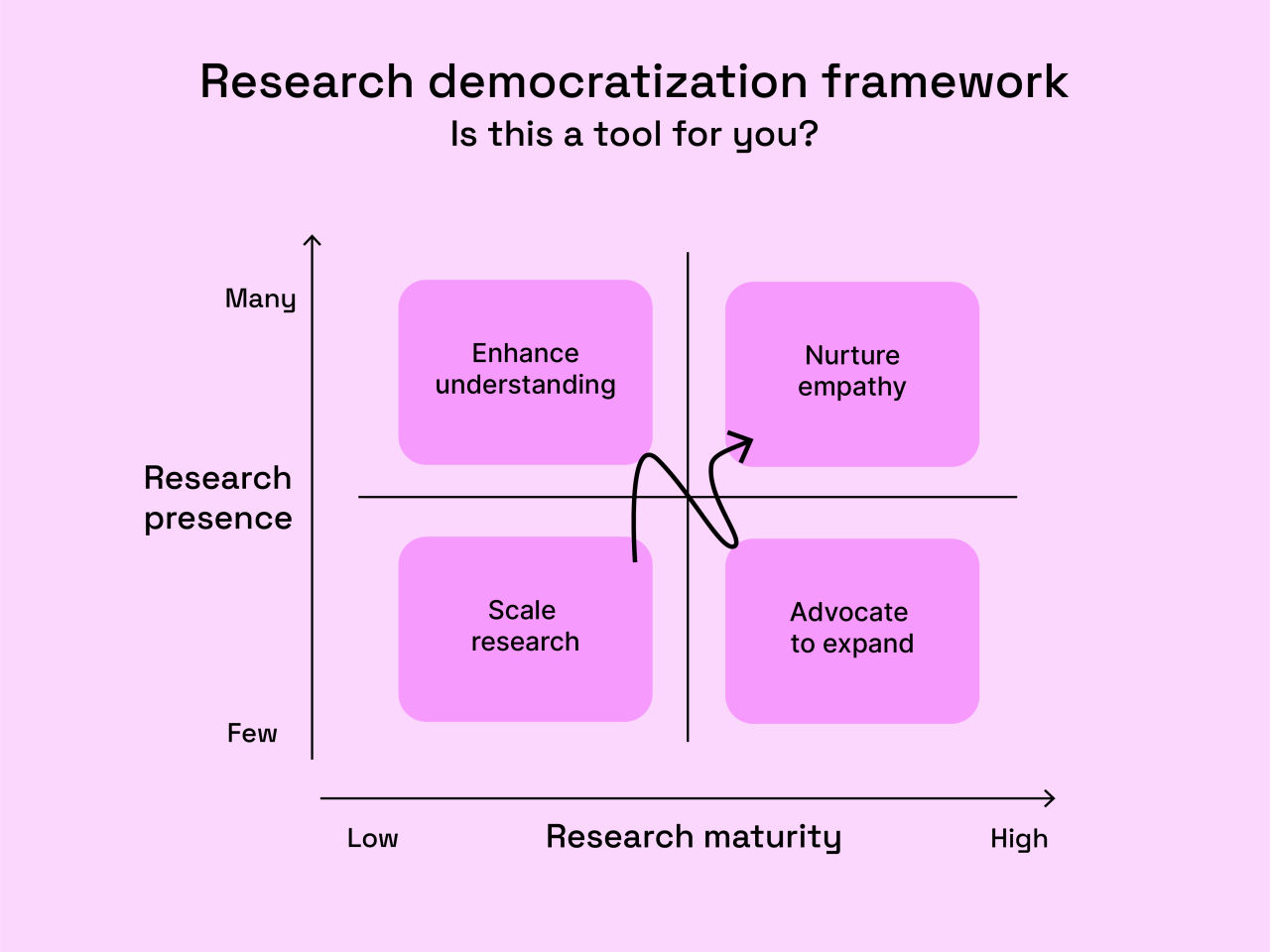The situational framework for research democratization

Democratization has its ups and downs.
Published
21 February 2023
Content
Creative
Read on to see the benefits, challenges, and applications of democratization for your circumstance.
If you follow UXR discussions on LinkedIn, you’re probably aware that there are two opposing camps on democratization: those who are for it (spoiler alert: I’m one of these people!) and those who think it’s a bad idea to let untrained researchers do user testing, let alone interview people.
This is often viewed as a black-and-white scenario, but what about all the shades of gray? Depending on the situation, there are benefits that lie in democratizing your research practice.
I’ve had several successful experiences in startups and large corporations where I have seen the magic of everyone rallying around insights. But even I have come to understand research democratization is not suitable for every scenario. It is one of the many tools we have at our disposal, and we should use it wisely.
The question you might ask yourself: is research democratization right for you? Let’s have a look together at different situations and what you might be able to achieve if you were to venture down the research democratization path.

Diagram: research democratization framework 01
Your situation: first hire or team of one
Working as a solo researcher is not a great experience. It’s difficult to improve your practice without peers to discuss your research, and the workload often exceeds your capacity. This spreads you thin, forcing you to prioritize ruthlessly and say “no” too many times.
If you’re lucky, getting buy-in for new hires might be easy. But often, we find ourselves caught up in having to demonstrate the ROI of hiring more researchers. Surprisingly, this is where research democratization could prove useful.
Training colleagues to do user research increases the number of people who understand our practice’s value and process. Every time I train people on research, we spend a lot of time on how to define good research objectives. This knowledge, in combination with a practical understanding of usability testing, is an easy way for them to see basic user research in action. The result is often a newfound respect for user research skills and the time it takes to get good at the craft.
This is where you win. By training colleagues, you impart an understanding of the value of research, the processes, as well as the time it takes. Knowing all this makes them your partners in crime when pleading for more resources. When the time comes to review budgets or to hire, the chances are high that you will have other disciplines vouching for more researchers.
It sounds like magic, but there is still a large caveat. It takes time. We are often promised that democratization will free up time, allowing you to focus on the research that truly matters. Let’s burst that bubble right away: this is not a good reason to share your practice. It requires quality control processes and is extremely time-consuming if done well.
Balancing the time and effort of democratization while maintaining sanity at work as the sole researcher is difficult. But if you enjoy teaching others, it could be the right way to go and worth your time to get buy-in to grow your team. (nb: if you want to consider a “lightweight” approach—look for designers or PMs with some research experience. They require less guidance, which can streamline the democratization process).
Your situation: embedded in product team(s)
When there are multiple researchers in a company, they’re often embedded in product teams. Of course, having the capacity to work like this is a fantastic way to ensure insights are gathered at all stages of product development.
At the same time, I have noticed researchers often find themselves caught up in the everyday activities of that particular team, leaving no time to work on strategic insights that go across product boundaries or inform the company strategy. This is where research democratization can play a role in helping your company mature.
When people from other disciplines start doing user research, they are more inclined to understand the value and ideal timing of insights needed for strategic product development. This increased awareness is the primary benefit of sharing your practice.
You can expect to see an increase in customer empathy among your stakeholders.
This leads to:
- Enhanced understanding of user needs among product teams
- Better formulation of research questions and research requests
- More allowance for big-picture thinking and strategic research that goes beyond product team silos
In this situation, research democratization can actually “free up time.” Of course, it takes some capacity to teach and guide your colleagues. But it does not have to be the responsibility of all researchers on the team. You can appoint a couple of researchers that facilitate research training and coaching. And since most product teams have had embedded researchers, the processes and application of research do not feel foreign to them. They have most likely seen you conduct research, making it a lot easier for them to learn and replicate (albeit on a more basic level than you would).
What are the potential downsides to this approach?
- Not every product team is willing to give up on having an embedded user researcher. Teams working with product discovery will have a tough time doing this type of research themselves. At the same time, teams going through a phase of fine-tuning and improving existing features could easily do user testing independently as long as they receive guidance
- Many researchers enjoy being embedded and directly impacting their product team’s work. You have to consider their needs to keep them on board in the long run
- Last but not least, there are significant challenges regarding insight sharing. Product teams tend to keep research outcomes to themselves, even with a process for documentation and dissemination in place. This is understandable. It takes time and effort to share findings, and it’s difficult to know what interests others
It’s important to provide active guidance around sharing insights. One solution I tried was to dedicate a researcher to a biweekly sync with the product team to discuss what they learned (insights gained) during the last sprint and what they planned to do next. That way, our researchers could stay on top of what teams were planning and make sure that they would share relevant insights with us and each other.
Your situation: the holy grail
If you work for a company with high research maturity and a large team of researchers, you are lucky to have reached the holy grail. At this stage, your colleagues know when to reach out to you and how to use your insights. Your work assists both strategic and tactical product decisions.
Does democratization still have a place here? Well, there is no need, but you could consider a lightweight version.
Let me share this example to illustrate. A startup I worked in pivoted from being a Scandinavian consumer product to delivering a B2B2C product with the whole world as a potential audience. This required the staff to better understand the financial decision-making parameters outside of Sweden and Norway.
The research team invited all our colleagues (including the C-suite) to conduct research together for a week. We recruited participants from several countries, had multiple manuscripts prepared, and allowed everyone to either interview, take notes, or observe the interviews. It was a research bonanza! To our excitement, practically everyone joined. Even the CEO took notes during several interviews.
What did the staff gain from this experience? Most of all, they better understood the cultural differences of these new markets we were entering. Learning this “collectively” allowed for our product discussions to start at the same level of understanding. For us researchers, the benefit was that our colleagues understood they could learn a lot before launching the MVP. The discourse shifted from “ship and learn” to “let’s discover the true needs.”
You can probably argue that this experiment does not qualify as “democratization.” It’s limited in time and effort compared to a continuing process that empowers others to research. At the same time, there are company-wide benefits to this “immersive exercise” that resemble the benefits of full-blown democratization. You can count on an increased understanding of insights, more awareness of your practice, and buy-in to continue insights-informed work.
The bonus is that you have created an immense buzz around the activity. Everyone is part of the same discussion and has been part of similar research that week. This creates interesting conversations and a new focus on discovering potential customer needs.

Diagram: research democratization framework 02
Side note on workplace culture, job security, and saying no
My positive experiments with democratization were in Scandinavia, where I was lucky enough to experience a work culture based on mutual trust. In Sweden, people are inclined to trust your competence, and very progressive labor laws protect employees. It was a given that my colleagues enjoyed trying new things outside their job descriptions, and I never feared for my job if one of my experiments failed.
I understand the situation is different elsewhere. In a place and space where your job is not as secure, it feels less obvious to share your practice. I have heard of examples where research democratization backfired, and people lost their jobs after training peers.
This is why I have to emphasize that keeping your practice to yourself and saying no to democratization is acceptable. What are other ways to achieve buy-in for increased headcount and research maturity? You can choose to prioritize ruthlessly. Say no to outsourcing research and no to projects with limited potential. Cherry-pick the work with the highest impact and let those insights speak for you. Once people see the impact of high-quality research, stopping the demand for more is difficult.
Ready to explore between black and white?
Based on the scenarios described above, it might be time to start exploring the gray zone yourself. The main takeaway is that if you desire to increase research maturity or headcount, democratizing your practice could be worth the time and effort. Enabling colleagues to do basic research continuously will lighten your backlog of requests in the long run. It also helps you identify the champions keen to move away from gut-based decision-making. You will gain many unexpected allies, enabling them to work insights-informed and have a lot of fun along the way.
Subscribe to Outlier
Juicy, inspiring content for product-obsessed people. Brought to you by Dovetail.